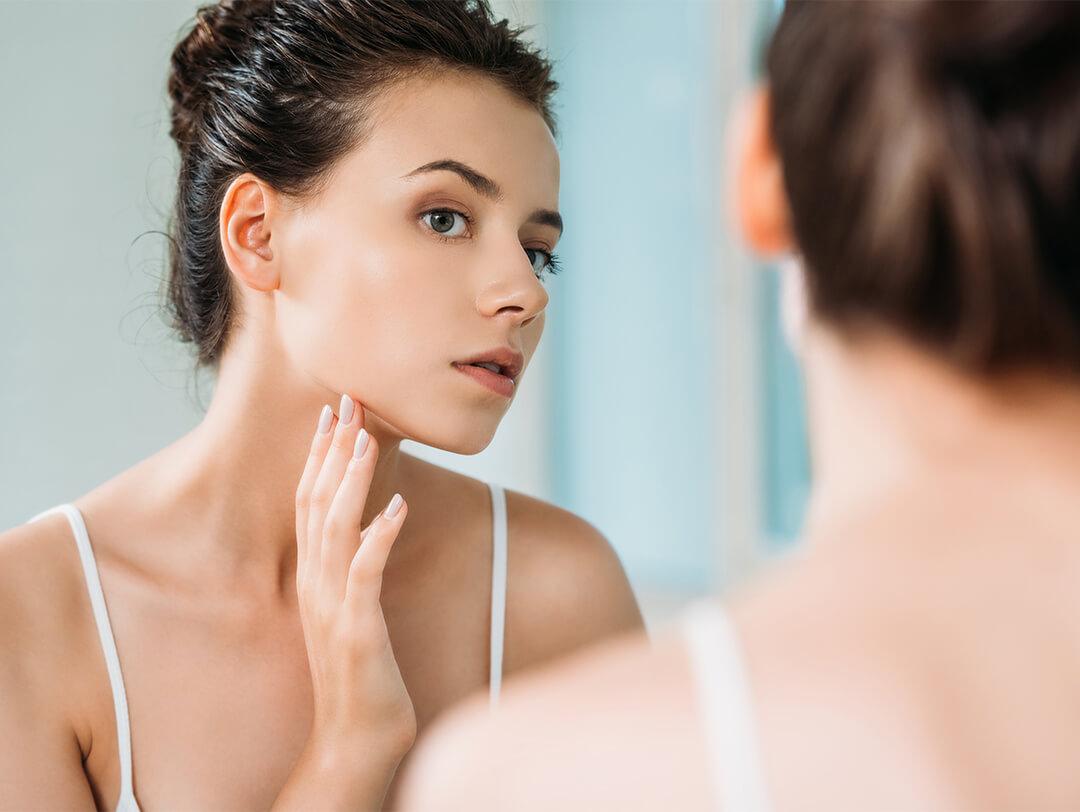Banish Cystic Acne Once & For All With These Derm-Approved Tips



IPSY Editors


While there are many different types of acne, cystic acne can be one of the most frustrating to deal with. Not only do these inflamed, under-the-skin pimples seem to pop up when you least expect them, but they can also be difficult to treat. Not sure if what you’re dealing with is cystic acne or something else? “Cystic acne tends to refer to deeper, red inflamed breakouts that often feel like they are underneath the skin,” says Marisa Garshick, MD, FAAD, board-certified dermatologist at MDCS: Medical Dermatology & Cosmetic Surgery in New York.
Unlike pesky blackheads or whiteheads, once you develop one of these deep blemishes it may feel like there’s no hope for a clear complexion—but take a deep breath—there are some things you can do to calm your skin and reduce the severity of your cystic breakouts. Read on for cystic acne treatments you can try at home and discuss with your dermatologist.


It's about glam time you treated yourself.
MEET THE EXPERT
Marisa Garshick, MD, FAAD, is a leading board-certified dermatologist at MDCS: Medical Dermatology & Cosmetic Surgery in NYC. and serves as an assistant clinical professor of dermatology at Cornell New York Presbyterian Medical Center.
What causes cystic acne?
There are a variety of factors that contribute to cystic acne, but unfortunately some of us are more inclined to experience them than others regardless of how strict you are with your skincare routine. “Often times cystic acne can be beyond your control,” says Dr. Garshick. That’s because genetics, hormonal changes, and stress all play a part. “Cystic acne is caused by increased oil production and bacteria, which can lead to clogged pores,” says Dr. Garshick. When your pores are clogged by bacteria, dirt, and dead skin cells, you’re left with swollen, painful breakouts that sit below the surface of your skin, deep within skin cells. Not only are these pimples painful, but if you attempt to pop them it can leave you with lasting acne scars, so it’s especially important that you handle cystic acne carefully. If you do see a pimple brewing beneath the surface, you should begin to treat it ASAP. “The smaller the breakout, the less likely to leave a scar,” says Dr. Garshick.
How to treat cystic acne at home:
1. Hands off!
While there are a variety of treatment options you can try at home, popping pimples is on the top of our don’t list. It may be hard to resist taking matters into your own hands, but attempting this can just make cystic acne worse. “Many people are tempted to squeeze them and often find they never truly come to a head,” says Dr. Garshick. Instead of improving the situation, you’re only going to magnify swelling and redness. “It can potentially risk leading to an infection if you introduce any new bacteria into the skin,” says Dr. Garshick. If you wind up with an infection you’ll be stuck with that zit for much longer than you would’ve had if you just left it alone. Trying to pop cystic acne also leaves you susceptible to scarring and discoloration, so resist the urge to squeeze.
2. Combine salicylic acid and benzoyl peroxide.
The first thing you should do if you feel a cystic pimple brewing below the surface? Reach for salicylic acid. “Salicylic acid is a beta-hydroxy acid and is a good exfoliant for those with acne-prone skin as it is oil—soluble so it can penetrate deep into the pores and help to unclog the pores,” says Dr. Garshick. Salicylic acid is the biggest threat to clogged pores, as it can penetrate below the surface and loosen up the dirt and grime causing the pimple in the first place. While manual exfoliation can be too harsh on a bad breakout, salicylic acid will give you the deep clean you need without further aggravating your skin.
From cleansers to spot treatments, salicylic acid is found in a variety of treatments. MURAD’s Time Release Acne Cleanser works up to 8 hours after you wash your face to keep acne-fighting bacteria at bay, making it an easy addition to your routine if you suffer from blemishes.
While salicylic acid is a powerful ingredient to add to your routine if you suffer from acne-prone skin, when combined with benzoyl peroxide it’s like a powerful one-two punch that more quickly works to clear out your pimple. “Benzoyl peroxide helps breakouts by reducing bacteria and inflammation, without leading to antibacterial resistance,” says Dr. Garshick. Salicylic acid will give you the thorough deep clean your skin needs and benzoyl peroxide will kill bacteria within the follicle to help reduce inflammation. If you have sensitive skin, it’s best not to overdo it with the benzoyl peroxide as it can cause further irritation. “Any strength of benzoyl peroxide may be effective and we generally suggest between 2.5%-10%, though the higher the strength, doesn’t necessarily translate to more effectiveness,” says Dr. Garshick.
3. Ice it.
If you want to reduce redness, the best home remedy can be found in your freezer. “Short applications of ice cubes can help to reduce redness by causing vasoconstriction or shrinking of the blood vessels, reducing both swelling and redness,” says Dr. Garshick. If you are in the middle of your morning routine when you spot a bad breakout, icing it will help you temporarily alleviate the situation so you can get on with your day.
4. Don’t skip moisturizer, but make sure it’s oil-free.
While you might think the last thing you need is moisturizer to fight a bad breakout, the truth is that without moisture, you will create an unstoppable source of oils for acne to feed off of. “It’s important to not let the skin dry out too much as this can actually trigger more oil production and possibly more breakouts,” says Dr. Garshick. When you attempt to “dry out” your skin, all you’re doing is kicking your oil glands into overdrive, which will result in more oil production as your skin works harder to overcompensate for the dryness. Increased oil = clogged pores, which leads to more acne.
Instead of skipping out on moisturizer, you’re better off reaching for an oil-free lotion, like the PURLISSE BEAUTY Matcha Green Tea Antioxidant Priming Moisturizer. This lightweight formula works on sensitive skin to soothe and nourish while also reducing inflammation to keep your skin balanced. “When dealing with cystic breakouts, often anti-acne products can be drying on the skin so it is especially important to use gentle moisturizers to help the skin better tolerate the anti-acne active ingredients,” says Dr. Garshick.
5. Use non-comedogenic makeup.
After you moisturize, it’s best to keep the area around your cystic acne clean, but sometimes it’s hard to feel comfortable going bare-faced. If you need to cover up with makeup to go about your day, make sure it’s non-comedogenic and oil-free. If you’re looking for a long-wear concealer, try TARTE COSMETICS Shape Tape™ Concealer which offers 16-hour coverage and is non-comedogenic. Some concealers and foundations also contain acne-fighting ingredients like salicylic acid to ensure you won’t further clog your pores.
You can also use makeup to color-correct the situation. “For those with redness-prone skin, it may be helpful to find a makeup with a green tint which can help to neutralize the redness and help to reduce the appearance,” says Dr. Garshick. If you’re looking for coverage that will calm redness, try DERMELECT COSMECEUTICALS Redness Rehab Conceal which offers full coverage and a heaping dose of soothing colloidal oatmeal to calm breakouts.
6. Reach for retinol.
Not only is retinol the secret to a successful anti-aging routine, it can also prevent breakouts by continuously clearing out pores to remove bacteria, dirt, and dead skin cells. “Vitamin A derivatives, such as retinol or retinoids, help to regulate skin cell turnover which helps to prevent pores from getting clogged,” says Dr. Garshick. Since topical retinoids also stimulate collagen production, over time with continued use, it can help improve the appearance of acne scars. “At the molecular level, retinoic acid diffuses through the cell membrane and binds to nuclear receptors to promote cell turnover,” says Dr. Garshick.
Cystic acne treatments your derm can help with:
1. A cortisone injection
While home remedies can certainly reduce redness and inflammation, the quickest way to zap away a cystic pimple is with a cortisone injection at your dermatologist’s office. “Cortisone injections can help to reduce inflammation associated with breakouts and are especially useful for deeper, painful nodules,” says Dr. Garshick. If you typically get squeamish at the thought of shots, you have no reason to worry. Getting a cortisone injection will take less than 10 seconds and it can clear up your pimple in just a day as it injects a low-dose steroid directly into the pimple, clearing it out quickly to alleviate both pain and swelling.
Not only can your dermatologist administer a shot, but they can also identify the type of acne you’re dealing with and provide you with a treatment plan to further prevent breakouts from popping up. “We always encourage our patients to stick with a routine for about 8-12 weeks before determining if it’s working or not as many products are designed to prevent new breakouts,” says Dr. Garshick.
2. Antibiotics
If over-the-counter treatments don’t seem to be helping, it might be time to try something stronger like a dose of oral medication or prescribed topical treatment made to help heal severe forms of acne. “Antibiotics that may be used for acne include topical antibiotics such as clindamycin, erythromycin, and a new product recently FDA approved called Amzeeq which is a minocycline foam, as well as oral antibiotics such as doxycycline, minocycline, sarecycline,” says Dr. Garshick. Not only do antibiotics work as powerful anti-inflammatory treatments to drastically help reduce the appearance of blemishes, they also clear out the bacteria responsible for the pimple in the first place.
It’s best to discuss treatment options and potential side effects with your dermatologist. Dr. Garshick advises against primarily relying on antibiotics for treatment because over time your body may develop a resistance to the treatment. “It is important to stay mindful of this and limit the course of antibiotics when possible.”
3. Accutane
If you find yourself frequently experiencing severe acne, it might be time to consider an ongoing acne medication. “Treatment options include spironolactone,” says Dr. Garshick. Spironolactone combats hormonal acne, which tends to pop up around that time of the month and is usually located on the lower third of the face, around the jawline. “Another consideration is accutane (isotretinoin) which is an oral A derivative,” says Dr. Garshick. The best candidates for accutane have typically experienced acne scars and hyperpigmentation and haven’t responded to other treatments in the past.
4. Birth control
You’ve probably heard that birth control pills can help clear up your complexion, and while in some cases it does hold true, not all birth controls are created equal. “There are certain birth controls that are officially FDA-approved for the treatment of acne so if considering birth control as a treatment for your acne, be sure to ask your doctor about one of these specifically,” says Dr. Garshick. The levels of estrogen and progesterone in birth control can help regulate hormonal fluctuations responsible for blemishes, but you shouldn’t expect to wake up with an entirely new complexion overnight. “It can take several months to see the benefits for birth control and acne so it is important to be patient,” advises Dr. Garshick. If you recently started a new birth control and developed cystic acne for the first time, it might be time to try a different prescription. “There are some birth control options that can worsen acne,” says Dr. Garshick, so it might be worth discussing with your doc.
Want to clear acne? Stick to these derm-approved tips and effective treatment options to banish bad breakouts once and for all.
Want in on all the Glam Bag fun? Take our Beauty Quiz now to get started. Already an Ipster? Refer your friends to earn points, which you can use toward products. Either way, don’t forget to check us out on Instagram and Twitter @IPSY.
Liked this post? Share!
Related Stories


Skin
How to Adjust Your Skincare Routine for Mature Skin in the Winter
Published on Dec 4, 2025 • 7 min read


Skin
Meet the Best Moisturizers for Winter, According to Dermatologists
Published on Dec 1, 2025 • 9 min read


Skin
What Is Inflammaging—and Why Everyone’s Talking About It
Published on Dec 1, 2025 • 8 min read


Skin
6 Skincare Trends to Have on Your Radar in 2026, According to Experts
Published on Dec 1, 2025 • 7 min read


Skin
We Grabbed Our Crystal Ball and Found These 6 Skincare Predictions for 2025
Published on Dec 10, 2024 • 7 min read


Skin
Simple Self-Care Tips That Actually Make a Difference
Published on Nov 13, 2025 • 12 min read


Skin
These 9 Face Scrubs Will Unlock Soft and Smooth Skin on Contact
Published on Nov 5, 2025 • 10 min read


Skin
10 Thanksgiving Foods That Will Have Your Skin Coming Back for Seconds
Published on Oct 15, 2025 • 7 min read


Beauty Picked Just for You
Get 5 products worth up to $70
Plus exclusive access to epic deals up to 80% off
Starting at just $14/month. Cancel anytime.